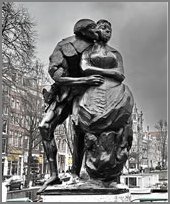What we are discussing here is a book written by G A. Bredero in 1617. The book was retranslated in 1992. The main character is a rather impish young man of noble birth who escaped his creditors in Antwerp and relocated to Amsterdam.  Here he faces hunger and poverty, and despite his displays of self-confidence, people experience him as rather irritating instead of amusing.
Here he faces hunger and poverty, and despite his displays of self-confidence, people experience him as rather irritating instead of amusing.
A Brabender is a person from Brabant, now a province of both The Netherlands and Belgium, but once it was a large dukedom that contained most of Belgium and a sizeable area in the south of the Netherlands. In Amsterdam, our character runs up large debts as well. His sidekick is called Robbeknol, once a beggar and, in fact, quite a bit smarter than his master.
The story mentions it occurring around 1575, but it’s quite obvious that Bredero wove events into his script that happened much later. Spain has conquered Antwerp, and many of its merchants and Calvinists retreat to Amsterdam. Antwerp was the financial centre of Europe in those days, and now, with the coming of its merchants, the city of Amsterdam took its place.
The Spanish Brabander Jerolimo (the main character) and his man soft Robbeknol develop an increasingly close relationship, mostly driven by hunger. Robbeknol starts up his old trade of panhandling and starts bringing home the bacon. In the end, the Spanish Brabander has to flee from his Dutch creditors as well.
The book entertains us with discussions between the two men about all sorts of commonplace subjects.
The interesting thing about them is that they are two totally different persons, from totally different backgrounds, who are forced to depend on each other for a rather long period of time. The question that remains with us is why this book was chosen to be a part of the canon of Amsterdam?
Bredero
Gerbrand Adriaenszoon Bredero was born on the 16th of March 1585 in Amsterdam. He died in the same city on the 23rd of August in the year of our Lord 1618. Bredero was a poet and playwright. He mostly wrote light-hearted plays, burlesque and comedy, sometimes with cynical overtones.
Amsterdam at the end of the sixteenth century
Amsterdam grew at an amazing rate, roughly with 5% per year between 1580 – 1620. The new immigrants were mostly people from other parts of the Netherlands, escaping the Spanish occupational forces. The South of the nation suffered most under the Spanish, who had an extreme dislike for protestants.
But the people of Bredero’s Amsterdam did not take kindly to all these new immigrants; they displayed a rather arrogant attitude and clothed themselves in high levels of self-righteousness. They also tried to take financial advantage of them. However, one reaps what one sows, and it wasn’t long before the city found out they needed these new folks. They happened to be far more inventive and driven than the somewhat lazy and not very clever original inhabitants. And we see the same thing today. It’s the Muslims who have taken over all the shops, working 24/7 and for far lower profits and wages than we would ever dream to consider.
And no, we don’t like it!
A map of Amsterdam
At the right of the page, we have displayed a map of the city of Amsterdam around the year 1600. this is what the city must have looked like in those days. This map has been provided by the Hebrew University of Jerusalem.
Linking the book, the city
The book seems to portray a rather accurate picture of life on the streets of Amsterdam during this period, the years between 1575 – 1610. It looks like the presence of all these strangers in town caused morality to sag; it changed the laws and customs the city had held onto for so long and so dearly. The cities administrators were accused of letting folk in that should have been kept out; the civil population was being made having to pay too high a price for comfort.
The book is, in reality, a comedy with its purpose to warn us in a light-hearted way of the dangers that lurk in the practices of swindling and inappropriate behaviour.
The play portrays the city as its people perceived it to be. They either present or not ironic overtones encourages the reader and indeed the observer to discern whether the irony is really there or not and if this is indeed the message the writer tried to get across.
De Canon of Amsterdam is obviously of the opinion that there is true, such a message hidden in its contents. In hindsight, one can even draw parallels with Bredero’s Amsterdam and the one we find ourselves in today. And that’s, of course, its purpose. For years now, our successive governments have been bending over backwards to get the autonomous Dutch to accept and embrace the hordes of immigrants it has allowed to settle here. Unfortunately for them, they are losing the battle. It’s their own fault, of course; they have been cow-towing to the migrants, offering them houses, jobs, insurance, health care, mosques and so on. While the poorer Dutch got nothing, all they got was lectures on their behaviour. Their concerns were ignored, and now they found a leader, a politician who hears their grieves and one they can vote for. And vote they did, his party rose from almost nothing to one of the biggest political movements of the nation. Of course, he’s vilified, demonized, and being called a populist, but his followers don’t care; they love him. The government was even forced to accept him as a partner as every left-wing party in The Netherlands refused to speak to him. Now they’ve got what they absolutely did not want, him in government.
De Spanish Brabander is window number 13 in the Canon os Amsterdam.